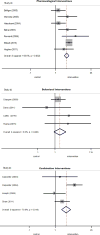Smoking Cessation for Smokers Not Ready to Quit: Meta-analysis and Cost-effectiveness Analysis
- PMID: 29903568
- PMCID: PMC6055474
- DOI: 10.1016/j.amepre.2018.04.021
Smoking Cessation for Smokers Not Ready to Quit: Meta-analysis and Cost-effectiveness Analysis
Abstract
Context: To provide a systematic review and cost-effectiveness analysis on smoking interventions targeting smokers not ready to quit, a population that makes up approximately 32% of current smokers.
Evidence acquisition: Twenty-two studies on pharmacological, behavioral, and combination smoking-cessation interventions targeting smokers not ready to quit (defined as those who reported they were not ready to quit at the time of the study) published between 2000 and 2017 were analyzed. The effectiveness (measured by the number needed to treat) and cost effectiveness (measured by costs per quit) of interventions were calculated. All data collection and analyses were performed in 2017.
Evidence synthesis: Smoking interventions targeting smokers not ready to quit can be as effective as similar interventions for smokers ready to quit; however, costs of intervening on this group may be higher for some intervention types. The most cost-effective interventions identified for this group were those using varenicline and those using behavioral interventions.
Conclusions: Updating clinical recommendations to provide cessation interventions for this group is recommended. Further research on development of cost-effective treatments and effective strategies for recruitment and outreach for this group are needed. Additional studies may allow for more nuanced comparisons of treatment types among this group.
Copyright © 2018 American Journal of Preventive Medicine. Published by Elsevier Inc. All rights reserved.
Conflict of interest statement
No financial disclosures were reported by the authors of this paper.
Figures
References
-
- U.S. DHHS. The Health Consequences of Smoking—50 Years of Progress: A Report of the Surgeon General. Atlanta, GA: DHHS, CDC, National Center for Chronic Disease Prevention and Health Promotion, Office on Smoking and Health; 2014. - PubMed
-
- Fiore MC, Jaén CR, Baker TB, et al. Treating Tobacco Use and Dependence: 2008 Update: Clinical Practice Guideline. DIANE Publishing; 2008. https://bphc.hrsa.gov/buckets/treatingtobacco.pdf. Accessed March 23, 2018.
-
- Tobacco Use and Dependence Guideline Panel. Treating Tobacco Use and Dependence: 2008 Update. U.S. DHHS; 2008. https://www.ncbi.nlm.nih.gov/books/NBK63952/. Accessed March 23, 2018.
Publication types
MeSH terms
Substances
Grants and funding
LinkOut - more resources
Full Text Sources
Other Literature Sources
Medical



